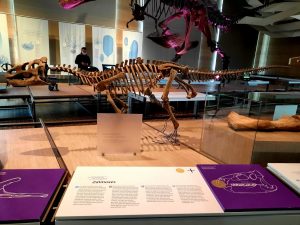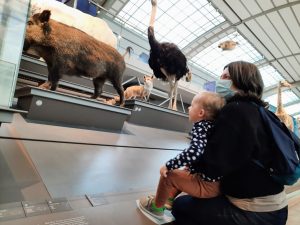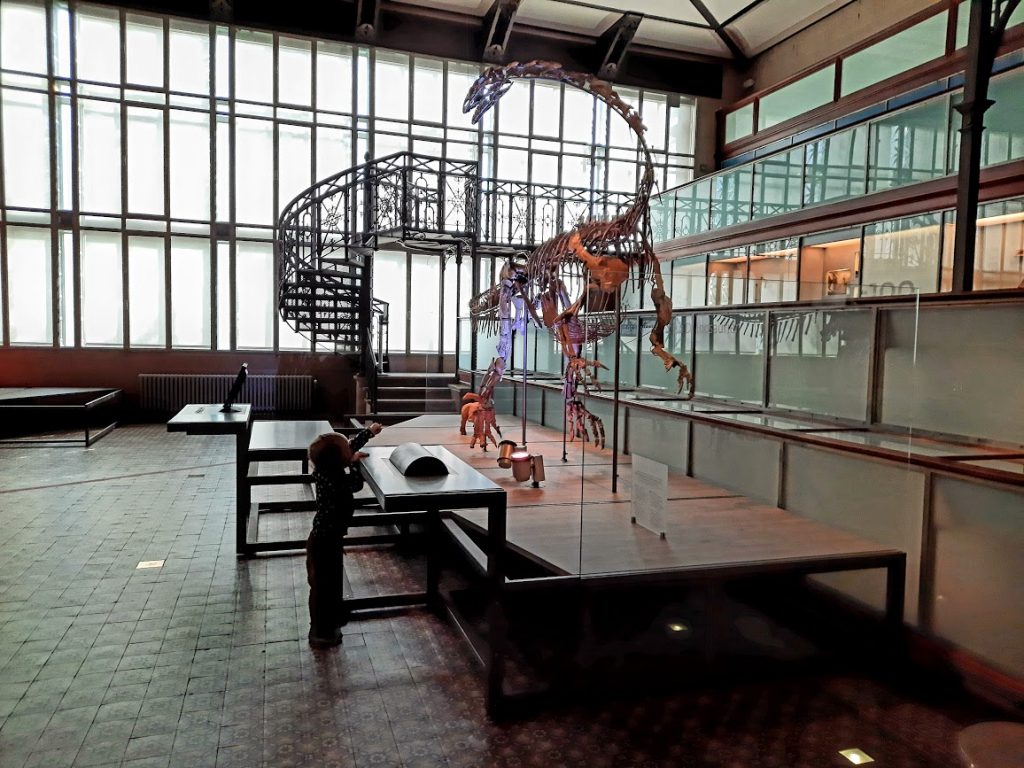Our first trip to a museum was to Belgium’s Museum of Natural Sciences, a few days after little gosling’s third birthday. We had been talking about going to museums ever since reading the James Mayhew’s Katie series. In our books, Katie visits art galleries, jumping in and out of Impressionist and post-Impressionist paintings, as well as a Natural History Museum, so we let ourselves be inspired.
We had set out to see the dinosaurs gallery, just like Katie in “Katie and the dinosaurs”, the biggest display in Europe entirely dedicated to dinosaurs, exploring their life and their evolution. Their display of original iguanodons skeletons, discovered in a mine in Belgium, is pretty impressive. It had never occurred to me before, but there were dinosaurs in my home country. I saw the mould of “Zalmoxes”, a small herbivore dinosaur that lived in Transylvania, which at the time was an island 😮

It was one of those settings that made little gosling feel over-excited, he was constantly on the move, running from one dinosaur skeleton to another – “look mummy! what is this?”, mostly looking around for the T-rex 😛 and squealing at every find, particularly the flying dinosaurs hanging down from the ceiling; climbing on platforms (when we weren’t quick enough to explain we were not allowed to touch any skeleton; no, that one either :P) or crawling under them. Luckily, the gallery is displayed in a vast, high-ceiling hall, with plenty of space to move around without risk of damage.
He courted for a while a virtual rendering of a Pachycephalosaurus frontly and angrily moving towards the viewer and smashing glass; he was very scared, but this “T-rex” 😛 attracted him terribly. After playing an approaching and going away game for 10-15 minutes, he decided he didn’t want to be there any longer or return again. Almost 45 engaging minutes spent in the museum, that’s a pretty awesome start!
From there, we moved on for a quick visit to a new exhibition called “The living planet”, that featured stuffed animals from all over the world. We spent some time identifying them. Little gosling really liked the giraffe, the zebra and the bear. I liked the fox and the butterflies. We only managed to see a small part of the exhibition before he displayed clear signs of tiredness and we called it a day. But we’ll go back. There was a nice part of the exhibit in which animals were exhibited against images of their habitat, which I think little gosling would have lots of fun exploring.

We kept talking about the dinosaur gallery, explaining the dinosaur had been scary for us too, but it was a movie; the dinosaur was not alive or real. He was safe. We were safe together. By the next morning, he was convinced. He declared he wanted to go back to the dinosaurs some day.
We explained there were many other museums we could visit and he immediately asked to go to a museum with planes or cars. Now he’s mentioning going to the museum almost every day and has made up his mind: the next museum needs to be the Autoworld, the cars museum. The aviation hall in the Military History Museum, the Museum of Musical Instruments and the Tram Museum will follow. We’ll definitely go back to the Natural Sciences Museum, there are so many things to see and learn. I’d love to see the Gallery of Humankind or the minerals, for example.
There are few museums I visited growing up. It was usually during summer camps or road trips with my parents that we’d visit memorial houses for famous writers, painters, historical personalities or historical monuments. In my youth, I preferred fortresses, castles and palaces or history museums to any other, although I checked the famous art museums in European capitals. I discovered science museums later and they made me regret not having grown in places where these were accessible; who knows, maybe I would have been more interested in sciences.
Museums broaden our knowledge of the world and instill appreciation for it; foster curiosity and open up a world of imagination, exploration and experimentation; encourage, support and foster love for learning. What an amazing exposure to science, art and history!! What a fun, solid foundation for intellectual growth and development…
The early years are incredibly important in developing the brains of children and lifelong learning begins at a young age. Children are interested in learning about content and are capable of understanding many concepts very early on. Museums expose children to learning possibilities in a rich and dynamic educational environment, like no other learning space. They can introduce unknown worlds and concepts through interactive exhibits and hands-on play, allowing children to take ownership of their own learning process.
Museums also offer unique environments for quality family time and an amazing alternative for engaging togetherness (particularly appealing for those days when the weather is less appealing for nature outings). Because visits to museums are special occasions, they become highly memorable for both children and adults – a shared intergenerational learning and joyful discovery experience – sparking enduring family conversations and family stories and memories.
All in all, museums encourage children to dream, wonder and fantasise. Museums inspire. All the reasons and benefits why we find it important to introduce little gosling to museums from a young age. Who knows, maybe it will help him discover his talents and passions and stimulate him to become a lifelong learner and, why not, a museum goer.


